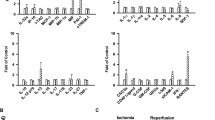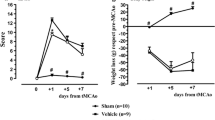Abstract
In order to evaluate the functional role of P-glycoprotein (P-gp) in cerebral ischemia, both multidrug resistance 1a knockout (KO) mice and wild-type mice were subjected to transient focal ischemia under a constant body and brain temperature about 37°C. The results showed that the volume of brain infarction induced by middle cerebral artery occlusion in KO mice was significantly smaller than that seen in wild-type mice, although there were no significant differences in cerebral blood flow, physiological data and on anatomical analysis of cerebrovasculature between both groups. We suggest that multidrug resistance 1a P-gp plays a role for adjusting the expressions of endogenous neuronal cell modulating substances, such as cytokines, neuronal peptides, and others, in the brain, which is consistent with a previous paper (Bobrov et al. Neurosci Lett 24: 6–11, 2008).



Similar content being viewed by others
References
Bobrov MY, Lizhin AA, Andrianova EL et al (2008) Antioxidant and neuroprotective properties of N-arachidonoyldopamine. Neurosci Lett 24:6–11. doi:10.1016/j.neulet.2007.11.010
Gottesman MM, Pastan I (1993) Biochemistry of multidrug resistance mediated by the multidrug transporter. Annu Rev Biochem 62:385–427. doi:10.1146/annurev.bi.62.070193.002125
Hsu SIH, Lothstein L, Horwitz SB (1989) Differential overexpression of three mdr gene family members in multidrug-resistant J774.2 mouse cells. J Biol Chem 264:12053–12062
Smit JJ, Schinkel AH, Oude Elferink RP et al (1993) Homozygous disruption of the murine mdr2 P-glycoprotein gene leads to a complete absence of phospholipid from bile and to liver disease. Cell 75:451–462. doi:10.1016/0092-8674(93)90380-9
Thiebaut F, Tsuruo T, Hamada H et al (1987) Cellular localization of the multidrug resistance gene product in normal human tissues. Proc Natl Acad Sci USA 84:7735–7738. doi:10.1073/pnas.84.21.7735
Cordon-Cardo C, O`Brien JP, Casal D et al (1989) Multidrug-resistance gene (P-glycoprotein) is expressed by endothelial cells at blood–brain barrier sites. Proc Natl Acad Sci USA 86:695–698. doi:10.1073/pnas.86.2.695
Pardridge WM, Golden PL, Kang YS et al (1997) Brain microvascular and astrocyte localization of P-glycoprotein. J Neurochem 68:1278–1285
Scinkel AH (1999) P-glycoprotein, a gatekeeper in the blood–brain barrier. Adv Drug Deliv Rev 36:179–194. doi:10.1016/S0169-409X(98)00085-4
Tishler DM, Weinberg KI, Hinton DR et al (1995) MDR1 gene expression in brain of patients with medically intractable epilepsy. Eplepsia 36:1–6. doi:10.1111/j.1528-1157.1995.tb01657.x
Schinkel AH, Smit JJM, van Tellingen O et al (1994) Disruption of the mouse mdr1a P-glycoprotein gene leads to a deficiency in the blood–brain barrier and to increased sensitivity to drugs. Cell 77:491–502. doi:10.1016/0092-8674(94)90212-7
Schinkel AH, Wagenaar E, Mol CAAM et al (1996) P-glycoprotein in the blood–brain barrier of mice influences the brain penetration and pharmacological activity of many drugs. J Clin Invest 97:2517–2524. doi:10.1172/JCI118699
Murozono M, Matsumoto S, Matsumoto E et al (2004) Neuroprotective and neurotoxic effects of cyclosporine A on transient focal ischemia in mdr1a KO mice. Eur J Pharmacol 498:115–118. doi:10.1016/j.ejphar.2004.06.068
Lazarowski A, Caltana L, Merelli A, Rubio MD et al (2007) Neuronal mdr1a gene expression after experimental focal hypoxia: a new obstacle for neuroprotection? J Neurol Sci 258:84–92. doi:10.1016/j.jns.2007.03.004
Ramos AJ, Lazarowski A, Villar MJ et al (2004) Transient expression of MDR-1/P-glycoprotein in a model of partial cortical devascularization. Cell Mol Neurobiol 24:101–107. doi:10.1023/B:CEMN.0000012728.19117.73
Sakai T, Johnson KJ, Murozono M et al (2001) Plasma fibronectin supports neuronal survival and reduces brain injury following transient focal cerebral ischemia but is not essential for skin–wound healing and hemostasis. Nat Med 7(3):324–330. doi:10.1038/85471
Swanson RA, Morton MT, Tsao-Wu G et al (1990) A semiautomated method for measuring brain infarct volume. J Cereb Blood Flow Metab 10:290–293
Kitagawa K, Matsumoto M, Yang G et al (1998) Cerebral ischemia after bilateral carotid artery occlusion and intraluminal suture occlusion in mice: evaluation of the patency of posterior communicating artery. J Cereb Blood Flow Metab 18:570–579. doi:10.1097/00004647-199805000-00012
Prestigiacomo CJ, Kim SC, Connolly ES et al (1999) CD-18 mediated neutrophil recruitment contributes to the pathogenesis of reperfused but not nonreperfused stroke. Stroke 30:1110–1117
Sheng H, Bart RD, Oury TD et al (1999) Mice overexpressing extracellular superoxide dismutase have increased resistance to focal cerebral ischemia. Neuroscience 88:185–191. doi:10.1016/S0306-4522(98)00208-5
Fernadez C, Buyse M, German-Fattal M et al (2004) Influence of the pro-inflammatory cytokines on P-glycoprotein expression and functionality. J Pharm Pharm Sci 7:359–371
Drach J, Gsur A, Hamilton G et al (1996) Involvement of P-glycoprotein in the transmembrane transport of interleukin-2 (IL-2), IL-4, and interferon-γ in normal human T lymphocytes. Blood 88:1747–1754
Raghu G, Park SW, Roninson IB et al (1996) Monoclonal antibodies against P-glycoprotein, an MDR1a gene product, inhibit interleukin-2 release from PHA-activated lymphocytes. Exp Hematol 24:1258–1264
Xiao-Dong L, Zhi-Hong Y, Hui-Wen Y (2008) Repetitive/temporal hypoxia increased P-glycoprotein expression in cultured rat brain microvascular endothelial cells in vitro. Neurosci Lett 432(3):184–187. doi:10.1016/j.neulet.2007.12.017
Spudich A, Kilic E, Xing H et al (2006) Inhibition of multidrug resistance transporter-1 facilitates neuroprotective therapies after focal cerebral ischemia. Nat Neurosci 9:487–488. doi:10.1038/nn1676
Zhu HJ, Liu GQ (2004) Glutamate up-regulate P-glycoprotein expression in rat brain microvessel endothelial cells by an NMDA receptor-mediated mechanism. Life Sci 75:1313–1322. doi:10.1016/j.lfs.2004.02.027
Hong H, Lu Y, Ji ZN et al (2006) Up-regulation of P-glycoprotein expression by glutathione depletion-induced oxidative stress in rat brain microvessel endothelial cells. J Neurochem 98:1465–1473. doi:10.1111/j.1471-4159.2006.03993.x
Felix RA, Barrand MA (2002) P-glycoprotein expression in rat brain endothelial cells: evidence for regulation by transient oxidative stress. J Neurochem 80:64–72. doi:10.1046/j.0022-3042.2001.00660.x
Bergeron M, Yu AY, Solway KE et al (1999) Induction of hypoxia-inducible factor-1 (HIF-1) and its target genes following focal ischemia in rat brain. Eur J NeuroSci 11:4159–4170. doi:10.1046/j.1460-9568.1999.00845.x
Marti HJ, Bernaudin M, Bellai A et al (2000) Hypoxic-induced vascular endothelial growth factor expression precedes neovascularization after cerebral ischemia. Am J Pathol 156:965–976
Smyth MJ, Krasovskis E, Sutton VR et al (1998) The drug efflux protein, P-glycoprotein, additionally protects drug-resistant tumor cells from multiple forms of caspase-dependent apoptosis. Proc Natl Acad Sci USA 95:7024–7029. doi:10.1073/pnas.95.12.7024
Johnstone RW, Cretney E, Smyth MJ (1999) P-glycoprotein protects leukemia cells against caspase-dependent, but not caspase-independent, cell death. Blood 93:1075–1085
Acknowledgments
This work was supported by Grant-in-Aid for Scientific Research (C) and (B) from the Japanese Ministry of Education, Culture, Sports, Science and Technology (no. 15591660: M. M. and no. 17390433: Y. W., respectively).
Author information
Authors and Affiliations
Corresponding author
Rights and permissions
About this article
Cite this article
Murozono, M., Matsumoto, S., Okada, S. et al. Reduction of Brain Infarction Induced by a Transient Brain Ischemia in mdr1a Knockout Mice. Neurochem Res 34, 1555–1561 (2009). https://doi.org/10.1007/s11064-009-9943-6
Received:
Accepted:
Published:
Issue Date:
DOI: https://doi.org/10.1007/s11064-009-9943-6




